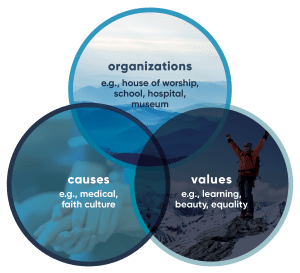How to Align Your Charitable Giving With Your Values
Sara sighed as she stared at the stack of envelopes on her desk, the ones from the charities she had given to in the past. Next to it lay a blank page titled “2024 Giving Plan.” She had promised herself this year would be different – she’d have a clear strategy for her donations. But now, faced with the pile, Sara felt overwhelmed and confused. How could she possibly choose among the countless worthy causes? And how much should she give to each?
As year-end deadlines loom, Sara’s dilemma may be familiar. Deciding whom to give to, when and how much is challenging until you have aligned your giving plan with your values, charitable causes and the organizations you support. Here are steps you can take to prepare your gifting intentions this season.
1. Discover where you are on your charitable journey.
Giving is a learning process. While there is no right answer to where we want to be on the path, it’s worth reflecting on where we are now and where we might like to be:
- Why are you thinking about your charitable journey now?
- Are you just getting organized or becoming more strategic?
- Are you focusing on issues and results or wanting to achieve greater impact?
- What barriers stand in your way?
Additionally, you might be navigating this process with others. Discuss your thoughts on giving with your spouse and family. Talking about money can stir up emotions just like any other vital conversation. That’s why it’s important to develop a shared family purpose. Reflecting on your values will help your purpose take shape.
2. Define your values.
Taking a moment to articulate our values is crucial to making financial decisions such as charitable giving. Writing them down makes them conscious and helps inform our thinking and planning. What are the values that you and your family aim to live by?

3. Decide which causes touch your heart.
Charitable giving isn’t just about finances – it’s about making a real difference. Determine causes that matter most to you by taking time to reflect on these questions:
- What is the change you want to see in the world?
- What good things do you want to support so there’s more to go around?
- Where might you invest in solutions to challenges concerning you?
Now, consider what philanthropic causes are working to bring about those solutions. These might be humanitarian, religious, educational, cultural or environmental efforts.
When we discover the overlap between our values and causes that resonate, we become more focused on choosing which organizations to support.
4. Evaluate organizations.
Choosing the right organizations for you to support requires careful consideration. A little bit of research can help make informed decisions:
- Look up the organization’s mission and programs to ensure they align with your values and chosen causes.
- Consider the organization’s impact and effectiveness in achieving its stated goals.
- Look for transparency in the organization’s operations and communication with donors.
If you want to dig deeper, you can also:
- Review financial statements and annual reports to understand how the organization uses its funds.
- Check charity rating websites like Charity Navigator or GuideStar for independent evaluations.
Remember, it’s not just about choosing well-known names. Sometimes smaller, local organizations can have a more direct impact on causes you care about.
Additionally, a strong personal connection to a charity may offer guidance. For example:
- Giving back: Many of us owe our success and well-being – or those of our loved ones – to a nonprofit and the amazing people who work there. How might you like to give back?
- Memorial giving: Giving money in memory of someone is a great inspiration.
- Paying forward: Maybe the teacher who saw promise in you isn’t around. But you could think about funding the next generation of teachers – or an organization that helps teachers develop their skills
5. Find alignment with your values, causes and organizations.
Bring focus to your charitable giving plan by examining where your values, causes and organizations overlap. Are the causes you’ve supported in the past truly in line with your values? Do the organizations you’ve given to take care of those causes effectively?
Try dropping some charities you’ve given to out of habit. That means you could increase support for organizations with a high level of alignment.
Seek Alignment in Your Charitable Intentions

6. Create your charitable plan.
Once you’ve considered your values, causes and organizations, your charitable vision should come into focus. Define your purpose with a charitable mission statement, or statement of purpose. In other words, how will your plan help support your vision for a better world?
Example: The purpose of my/our charitable plan is to honor our professional experience in the medical field by funding innovative research and supporting organizations that provide health care in underserved communities.
Other essential items to consider:
- Who will you have conversations with about your charitable plan?
- How will you choose to give to those organizations?
Your options for giving might include cash, appreciated assets, a donor-advised fund (DAF), qualified charitable distributions (QCDs), a charitable remainder trust (CRT), or a combination of these. Working with your wealth advisor can help decide which options fit best with your overall financial plan. Your advisor can also help ensure more of your donation goes to your intended charitable causes rather than to taxes.
Conclusion
By following this structured approach to your charitable giving, you’ve taken significant steps toward aligning your donations with your values and maximizing your impact. Remember, effective philanthropy is a journey, not a destination. As you implement your giving plan this year, you’ll gain insights that will help you refine your strategy for the future.
Don’t let the complexity of charitable giving overwhelm you. With a clear understanding of your values, chosen causes and preferred organizations, you’re now empowered to make meaningful contributions that reflect your personal mission.
For informational and educational purposes only and should not be construed as specific investment, accounting, legal, or tax advice. Certain information is based on third-party data and may become outdated or otherwise superseded without notice. Third-party information is deemed to be reliable, but its accuracy and completeness cannot be guaranteed. Neither the Securities and Exchange Commission (SEC) nor any other federal or state agency have approved, determined the accuracy, or confirmed the adequacy of this article. Please be advised that Buckingham only shares video and content through our website, Facebook, LinkedIn page, and other official sources. We do not post investment advice on WhatsApp, Telegram, other interactive applications, or other similar platforms. Rather, Buckingham provides investment advice only through individualized interactions. R-24- 7661











